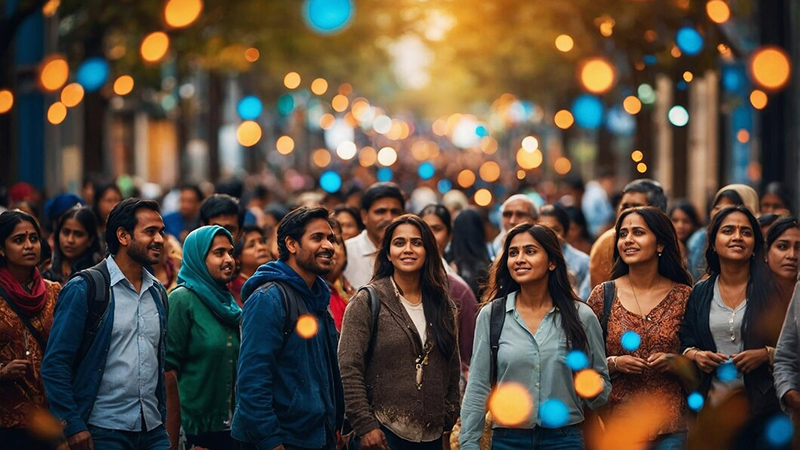The ‘Indian century’ will be powered by the connected Indian, the global Indian when the country completes 100 years as a developed nation in two decades, in 2047. It will be a culmination of the tryst with destiny. Meanwhile, average desis are struggling to find their feet at home and abroad as the West and the US, in particular, are tightening the rules in immigration.
Thousands clamour for coveted H1B visas as the pushback from some Republican quarters grows with (unfounded) concerns rising about Indian-Americans gaining control of the tech ecosystem. Some headlines recently screamed: ‘Indians are the new Jews’ while touting their success, which may be an exaggeration, but there are similarities between the two peoples who have forged a close bond over the last decade under the Narendra Modi government.
Yet, India’s problems are uniquely economic and social in nature that call for much introspection from policy pundits and the New Delhi government.
Non Resident Indians (NRI) Persons of Indian Origin (PIO) are indeed digitally talented, well-travelled, educated and are looking for opportunities, but face bias and discrimination in salaries and positions that align with their skillset. An Indian passport can get visa-free access to only 85 countries, according to some surveys.
Indians are often mocked for their regional accents, while a French, Italian or even Arab accent is considered hip and global. While Indians on the global stage strike back with their growing stories of success, the West refuses to acknowledge or bask in their glow. It has failed to acknowledge – to some extent – the rise of a new India, and the global Indian who is set to travel farther in the world. There’s also cultural angst in some quarters, and those on the right who fear an excess of India.
Leaders of Indian origin have come and gone in countries like the UK and Ireland. Even the world’s greatest superpower, the US, was recently on the cusp of electing an Indian-origin President in Kamala Harris, who some critics said projected her Black background to appease the electorate.
Harris may have been roundly defeated by Donald Trump, but the Indian influence on global politics and economy is only growing stronger. The Indian century is here, but has to be traversed carefully.
While human capital should be viewed positively, there are way too many Indians in India and and abroad – 1.4 billion out of the 8 billion world population. The world may not be enough for all of them.
Back home, what’s more concerning is that youth employment is at 10.2 per cent. The Indian Ministry of Labour has countered the data by saying this is lower than global levels of 13 per cent, which is 65 million young people between the ages of 15-34.
Even more disconcerting is that states like Kerala, with the highest literacy rate in the country, has among the highest youth unemployed population (29.9 per cent), after Lakshadweep (which has Kerala links), and the Andaman and Nicobar Islands.
Kerala trails the north and northeastern states in worker-population ratio (WPR) – the percentage of employed people in the population. Its economy has among the highest remittances from NRIs and people of Indian origin (PIOs). India’s economy, meanwhile, continues on its growth path with its GDP exceeding $3.94 trillion in 2024.
The country has benefited from its vast human capital over decades but it’s always a good time to pivot as the world and the West appear to be closing their doors to unchecked and illegal migration, while making it harder for legal and talented migrants to move in search of jobs.
In this scenario, the Modi government’s Viksit Bharat @2047, an ambitious, long-term vision, envisions a developed country which could give it more clout on the world stage and a seat at the UN Security Council table.
Inclusive development, sustainable progress, and effective governance, is the mantra, which is laudable. The grand plan is to deliver on the promise and potential of the country. But for that to happen, employment opportunities must be created for local youth while getting the best out of the diaspora by luring talented and smart ones home, much like Elon Musk’s plan for the US, that has met with opposition.
The AI revolution and smart tech would require new skills, which should kickstart reforms in the education system that has failed to keep pace with smart learning systems and tech that have overtaken it. The current growth of 6.5 per cent is insufficient, hence it’s important to unleash more reforms that benefit the middle class who are straining under the weight of expectations while struggling to make ends meet.
India’s reforms should continue, at a faster pace; workers called re-skill; there must a re-learning. re-thinking in the education system, and talented NRIs and PIO must be lured to return home, when the time is right, to rebuild and revitalise the country. The Indian century may be upon the world. Global Indians must seize the moment. They may be going places but still have a long way to go. – Photo by freepik – editor@nrifocus.com


Leave a Reply